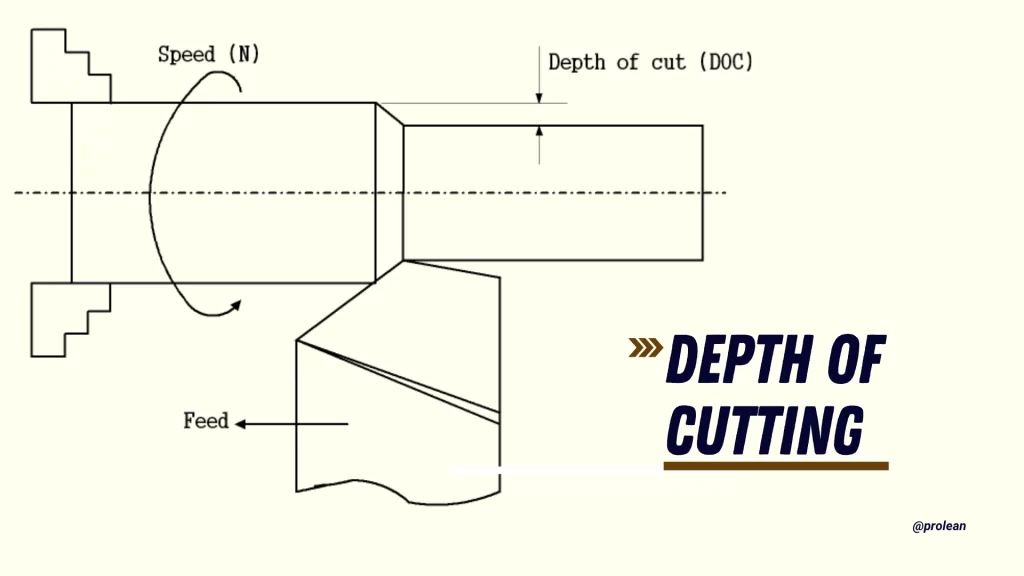
Depth of Cutting
Depth of cutting is regarded as the most critical parameter in CNC machining. It defines how deep your CNC cutting tool goes into the material with each pass. While it may seem like a simple setting, it plays a central role in your machine’s performance.
Getting the depth right helps you improve surface finish, speeds up production, and protects your tools from early wear and tear. Too shallow, and you waste time on extra passes. If it’s too deep, it can lead to tool breakage, part defects, or machine damage.
When you learn how to adjust the depth of cut correctly, you can take control of the quality and efficiency of the cutting process. It helps you balance performance with tool life, reduce material scrap, and maintain consistency across machining projects.
What Is the Depth of Cutting In Machining?
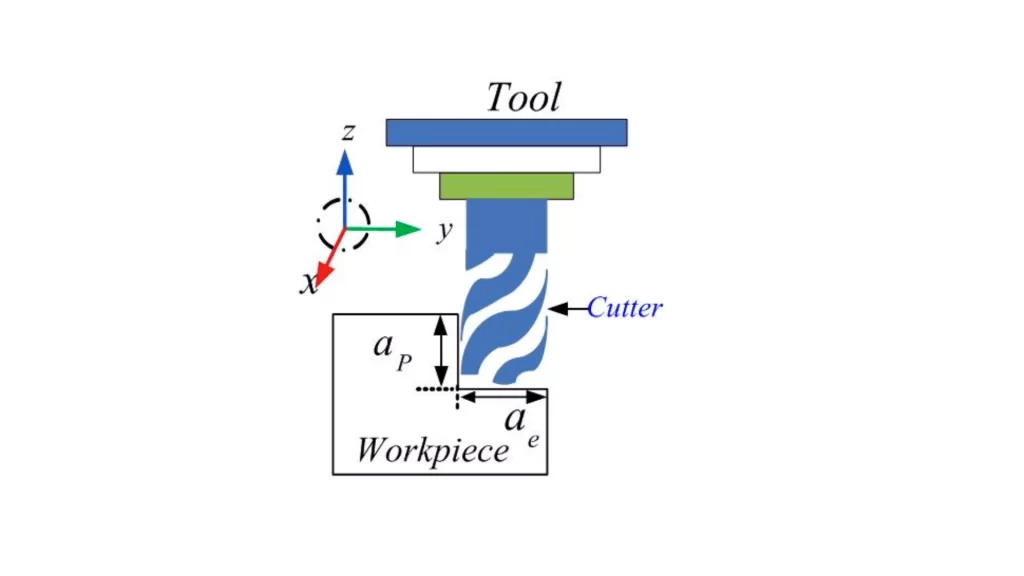
Depth of a cut: Illustration
Depth of cut is how far your tool goes into the workpiece each time it passes. It regulates the amount of material the tool takes to become a chip. Cutting depth is typically measured in millimetres and inches. In precision work, it usually ranges from 0.1 to 1 mm.
During the cutting operation, the tool traverses over the surface while maintaining a constant depth. That fixed depth is called the depth of cut. It plays a key role in the removal and surface quality. Accurate adjustment increases finish and process effectiveness.
There are two main types of cut depths used in custom machining.
- Radial Depth of Cutting: Radial Depth of Cut (in milling) refers to the width of the cut, measured perpendicular to the spindle axis.
- Axial Depth of Cutting: Axial Depth of Cut is the depth the tool enters along the spindle axis, i.e., the vertical engagement of the tool with the workpiece
Formulae For Depth of Cut
You can calculate the depth of cutting using a simple formula. It helps you set the proper cutting engagement for machining operations.
Use this formula:
ap = (dw − dm) / 2
Where,
- dw (original workpiece diameter)
- dm (final machined diameter)
The above expression gives you the depth removed on one side of the part. It allows accurate machining and helps you prevent tool overload.
For different machining methods, the respective formulae are given below.
Depth of Cut Formula for Milling
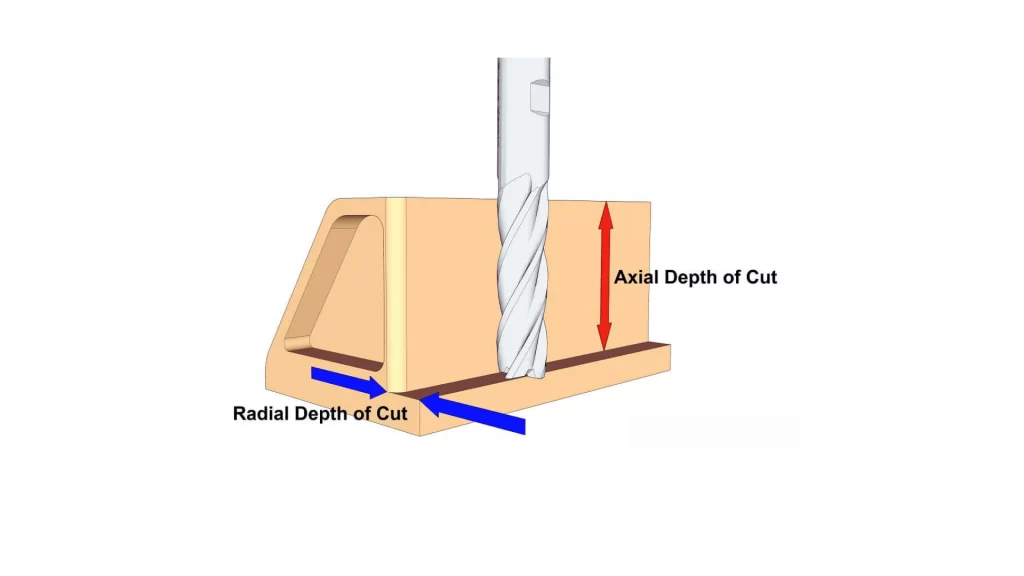
Axial & Radial Depth of Cut
In milling, depth of cut is defined as how deeply the tool cuts into the material. It is usually measured along the tool’s axis.
In milling, axial depth of cut is measured along the tool’s axis and is typically user-defined per pass. It is based on tool diameter, material, and machine capability.
Axial Depth of Cut ≈ 0.5 to 1.5 × Tool Diameter, depending on application. Usually, deeper cuts remove more material but increase tool load.
Depth of Cut Formula for Turning
In CNC turning, the tool cuts across the diameter of the workpiece. The depth of cut shows how much is removed from one side.
Formula:
Depth of Cut = (Starting diameter − Finished diameter) ÷ 2
This helps you set the right tool path for each pass.
Depth of Cut in Lathe Machine
On a lathe, the depth of cut is measured as how far the tool moves into the spinning workpiece. It controls how much material is cut off. Minor cuts are recommended for finishing, and deeper cuts are recommended for fast roughing. But, stay within the machine’s limits.
Why Depth of Cut Is Important in Machining
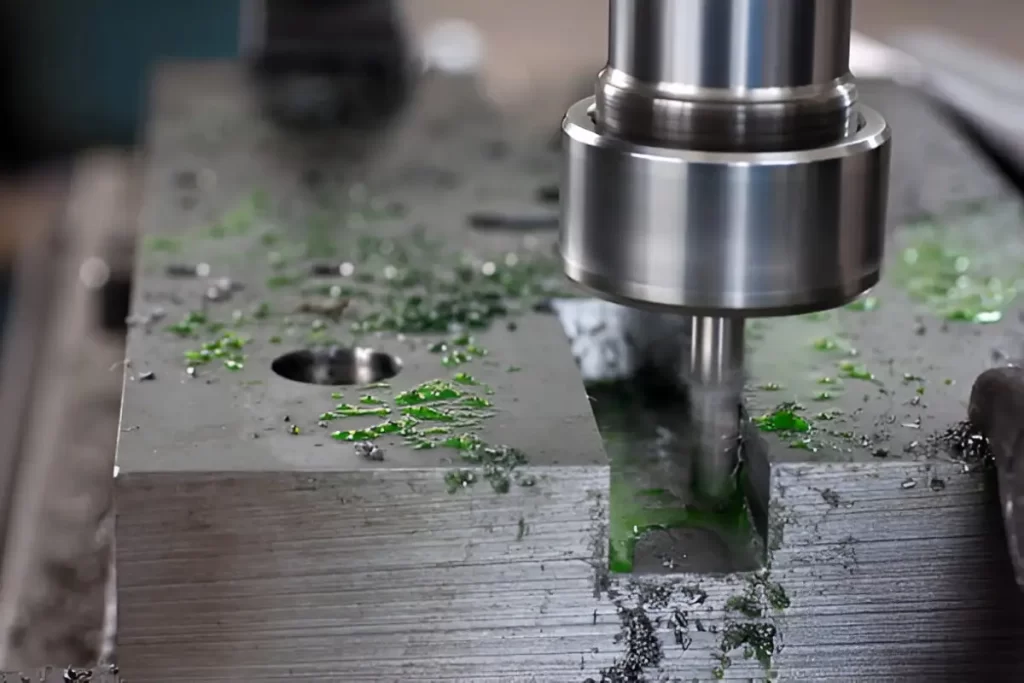
Cutting Depth Importance In Machining
Depth of cut directly affects all primary machining outcomes. For example, it influences tool wear, finishing, heat build-up, and tensile strength of your finished part. If you set it incorrectly, you will pay dearly, end up with low quality, and minimal tool life.
When you cut too deeply, you subject your tool to more stress. This may increase tip heat, wear, and an inconsistent surface. Moreover, it gives rise to the possibility of a built-up edge in certain materials such as annealed metals.
Built-up edge appears when the chips are adhered to the cutting edge of a tool. If these remain uncontrolled, they cause damage to the surface of your part. With the careful handling of the depth of cut, you can eliminate these issues and maintain your outcomes steady.
How Can You Calculate the Depth of Cutting?
To calculate the depth of cut, you need to consider how the machining parameters relate. Each setting significantly impacts the tool’s performance and the final outcomes. Before setting the depth, consider process type, material, and machine limits.
When planning a cut, we suggested that you review the following:
- The CNC machining process in use, like turning or milling
- The stability and power of your machine
- Material type and workpiece hardness
- Tool geometry and edge condition
- Tolerance and surface finish requirements
The following considerations help you define each pass’s safe and efficient depth.
Calculating Depth of Cut in CNC Turning
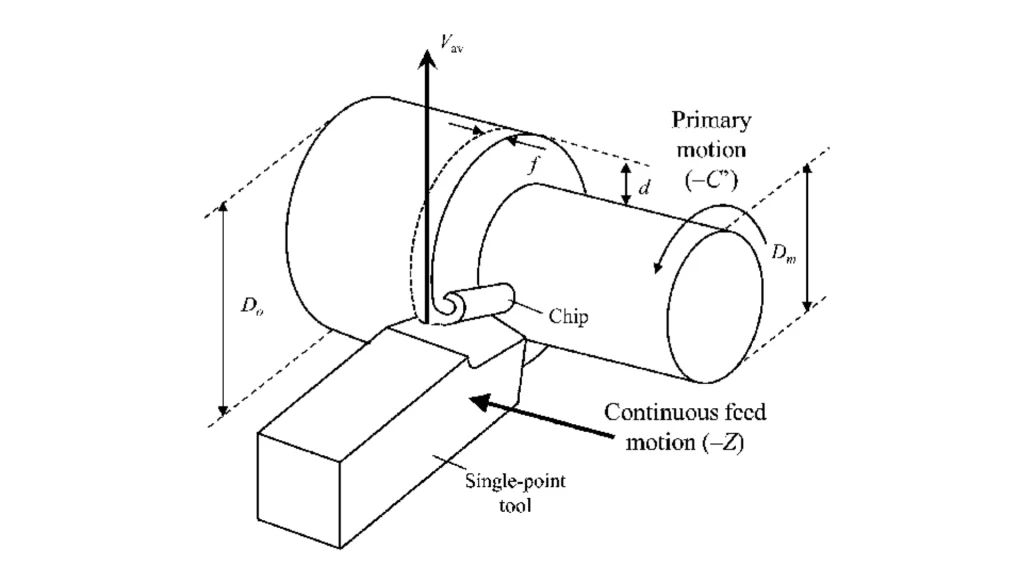
Calculating Depth of Cutting in CNC Turning
In CNC turning, the workpiece rotates while the tool moves along its length. The depth of cut refers to how deep the tool cuts into the diameter, while feed rate refers to the distance the tool moves along the workpiece per revolution.
Calculating Depth of Cut in CNC Milling
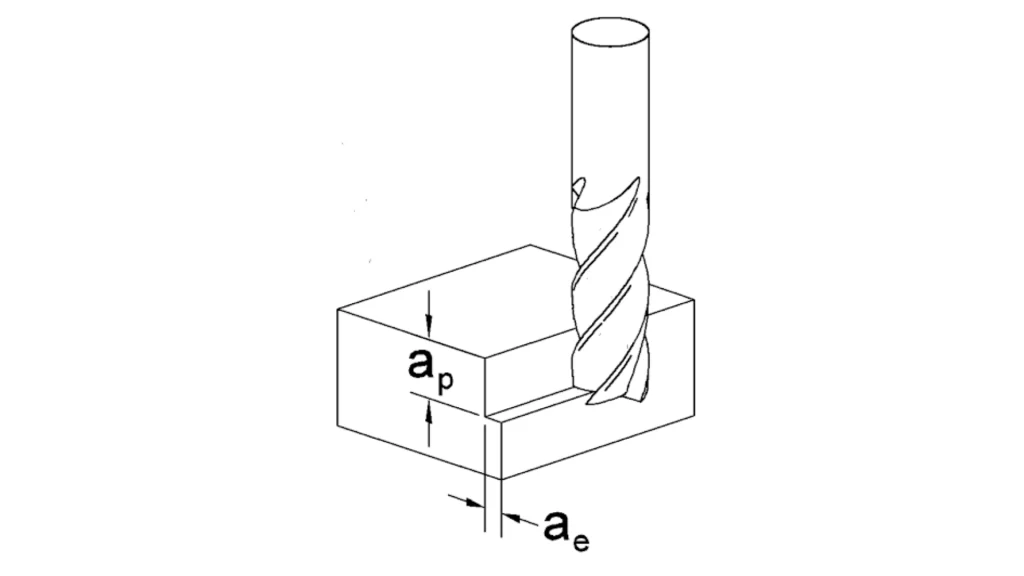
Cutting Depth Calculation in Milling
In a CNC milling operation, the cutting tool rotates, and the workpiece remains fixed. Depth of cut defines how deep the tool enters the material per pass. As a general guide:
For tools over 20 mm in diameter, a safe axial depth is typically 0.5 to 1.5 times the tool diameter. Using excessive depth (e.g., 4× or more) can cause tool deflection or breakage. These are starting points. You can constantly adjust based on material, tool strength, and machine stability.
Try Prolean Now!
How Depth of Cut Influences Other Machining Factors
Depth of cut may seem simple at first glance. However, it links closely with every primary setting in CNC machining. While operators can adjust it independently, it directly shapes surface quality, tool load, and heat stability during cutting.
Depth of Cut, Rake Angle, and Spindle Speed
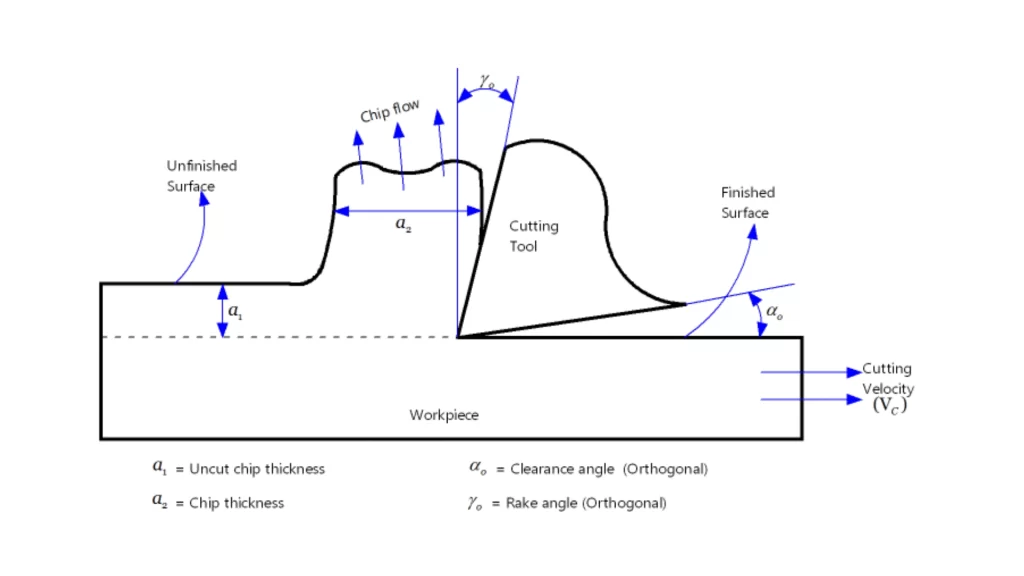
Rake Angle Demonstration
Particularly, thermoplastics are highly susceptible to heat at the tool’s tip. Because they have low modulus and low thermal conductivity. When heat accumulates too quickly, then chip gumming and sticking may happen. To avoid this, you must keep a balance of three things:
- depth of cut,
- rake angle, and
- spindle speed
These settings affect one another. For instance, the deeper penetration causes more heat. A bad angle of the rakes collects chips. Excessive speed creates friction. Feed rate, speed, and depth of cut are the key factors contributing to tool wear.
Depth of Cut and Cooling Fluid
A more minor cut of depth yields curlier chips. You may think that coolant can mitigate such issues. However, it is not always the case. Coolant causes chips to curl in several situations. This reduces interaction of the chip and tool, localizing heat at the cutting edge.
This heating increases the tools’ wear even when coolant is applied. If this happens, you need to use a chip breaker. It assists in the control of chip shape and prevents the heat from the critical contact areas.
How Is Depth of Cut Different from Chip Thickness?
Knowing the difference between depth of cut and chip thickness helps you optimize machining performance. Though both terms seem related, they represent different aspects of the cutting process.
Depth of Cut versus Chip Thickness
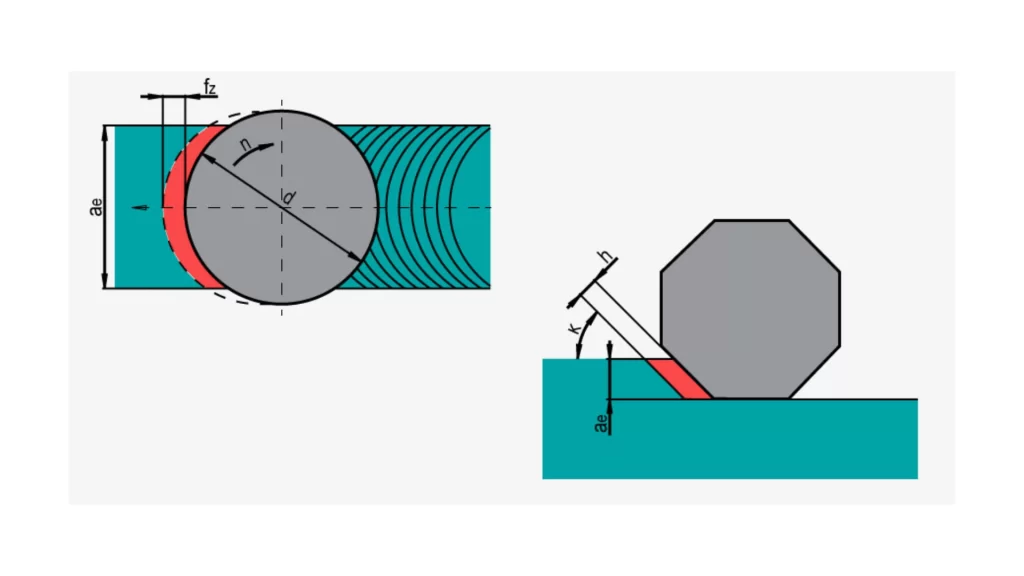
Average Chip Thickness Calculation
The depth of cut gauges how far the tool cuts into the workpiece. Chip thickness is the layer thickness of material removed and produced as a chip. It tends to be more than the depth of cut because of the shear and the rake angles.
Cutting Ratio and Chip Compression Ratio
The ratio of depth of cut to chip thickness is called the cutting ratio. It is computed as the ratio of the depth of cut and the chip thickness. This depends on the rake angle and shear angle of the tool. The cutting ratio is the ratio of uncut chip thickness to chip thickness, influenced by rake and shear angles. Chip formation involves plastic deformation and shear, not material compression.
Depth of Cut about Cutting Forces and Power
Cutting force is the force that your tool encounters while removing the material. It rises with an increment in the depth of the cut and influences surface finish and tool wear.
The cutting force is multiplied by the spindle speed to get the required power. This is the power needed to overcome cutting and friction forces.
Knowing these forces, you can choose the appropriate tools and machine settings. This assists in ensuring efficiency, tool life, and quality of parts during the process.
What Is the Minimum Depth of Cut in Machining?
The minimum depth of cut is usually around 0.1 millimeters. It is mainly used for finishing to give a smooth surface and tight tolerances. This shallow cut helps you eliminate tool wear and extends tool life while maintaining part quality.
What Is the Maximum Depth of Cut in Machining?
The maximum depth of cut can be as high as 10 millimeters. It depends on the tool and process. It is commonly used in roughing to remove material quickly. However, deeper cuts increase stress on tools and machines. These potentially reduce tool life and affect cutting stability.
Try Prolean Now!
Helpful Considerations to Determine the Optimal Depth of Cut
Getting the correct depth of cut right takes careful planning. Because several factors work together to affect tool life, finish, and speed. You need to balance them to keep your process stable and efficient.
Material Properties
The choice of material determines your cutting depth. The harder metals will require shallow cuts to prevent rapid wear. The cut can be deeper with softer materials to reduce the machining time.
Consider brittleness and heat. Sensitive to heat, parts can deform, and brittle ones can chip off with deep cuts. In such instances, lighter passes should be used to remain safe.
Type of Machining Operation
The type of operation determines your depth settings. To remove more material, use deep cuts in the roughing. These passes aim to balance speed and smoothness. You often require less depth to improve surface detail when finishing. Complex shapes like contours need careful control of cut depth.
Machine Tool Capability
The power and stiffness of your machine restrict the depth of your cut. A stiff setup is capable of handling deep passes without getting inaccurate.
When the machine is weak, it can make your cuts light. Contemporary CNC machines can also control depth automatically depending on load.
Cutting Tool Characteristics
The performance of depth is influenced by tool material and shape. The stiff tools are coated and harder and cut deeper.
Other alterations of tool shape affect chip flow and heat spread. A well-designed tool allows you to cut cleaner and wear less.
Prolean: Your Trusted Partner for Precision Machining
Machining demands careful attention to critical factors, and it is hard to determine precise parameters and evaluate the machinability of a specific material.
Prolean offers reliable custom CNC service that are effective yet affordable. To guarantee that each parameter is consistent with your project requirements, our engineers design custom machining strategies to fit your project needs.
We also view each part carefully to ensure your products are of top quality.
FAQ’s
Q1: How Do You Define the Depth of Cut?
Depth of cut shows how deep the tool goes into the workpiece. It measures how much material you remove in one pass. You adjust it to control surface finish and tool life.
Q2: What Is the Depth of Cut of a Drill?
In drilling, “depth of cut” is typically referred to as hole depth, the total distance the drill penetrates the workpiece. It decides how deep the hole will be. You must set it right to protect the tool. This also ensures clean holes and accurate depth control.

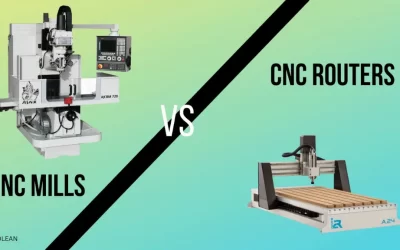
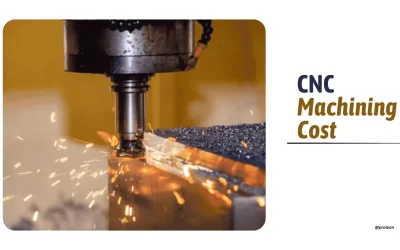
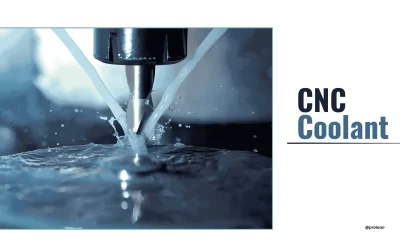
0 Comments